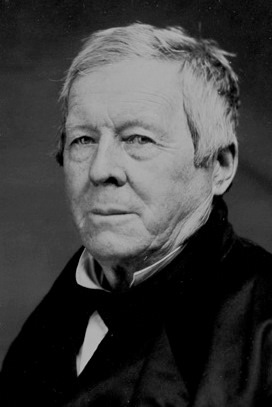Thomas Garrett: A Legacy of Abolitionism and Human Rights

Thomas Garrett (1789–1871) was a prominent 19th-century American abolitionist, best known for his tireless work in the Underground Railroad. A Quaker by faith, Garrett’s dedication to ending slavery left an indelible mark on the fight for human rights, positioning him as a significant figure in the abolitionist movement. His story is one of unwavering commitment to justice, often risking personal safety, financial ruin, and his reputation to help others.
Early Life and Influence
Born on August 21, 1789, in Upper Darby, Pennsylvania, Thomas Garrett grew up in a Quaker household. The Religious Society of Friends, commonly known as Quakers, was deeply opposed to slavery. Garrett was profoundly influenced by this faith, which emphasized equality, peace, and the inherent worth of every individual, regardless of race or status. His early experiences shaped his worldview, particularly one event that ignited his passion for the abolitionist cause.
As a young man, Garrett witnessed the attempted kidnapping of a free African American servant in his family’s employ. This event made a lasting impression, cementing his resolve to dedicate his life to helping enslaved people escape their bonds.
A Commitment to Abolitionism
Garrett’s dedication to abolition grew throughout his life. By the early 1820s, he had moved to Wilmington, Delaware, a slave-holding state but geographically significant for freedom seekers escaping to the North. In Wilmington, Garrett became a key “stationmaster” on the Underground Railroad, helping over 2,700 enslaved people to freedom during his lifetime.
His home and business in Wilmington served as safe havens for those escaping bondage. Despite Delaware’s slave-holding laws, Garrett refused to let fear deter his work, risking fines, imprisonment, and his fortune.
Role in the Underground Railroad
As one of the most active conductors on the Underground Railroad, Garrett’s name became synonymous with the secret network that aided enslaved people in their journeys to freedom. His house was an important station on the route north, and he worked closely with other abolitionists, most notably Harriet Tubman.
Garrett was known for his practical support. He provided money, clothes, transportation, and food to freedom seekers. His house was a safe refuge, and he developed contacts throughout the Northern states, ensuring those he helped could continue their journeys with minimal danger.
Harriet Tubman and Thomas Garrett
One of Garrett’s closest collaborators was Harriet Tubman, a former enslaved person who became the most famous “conductor” on the Underground Railroad. Tubman personally led over 70 enslaved individuals to freedom, and Garrett played a crucial role in her efforts by providing resources and shelter during her missions.
Garrett referred to Tubman as “Moses,” a testament to her bravery and leadership in the abolitionist cause. Their partnership showcased a remarkable synergy in the fight against slavery, with Garrett’s resources and Tubman’s field expertise making a formidable combination.
Legal Battles and Financial Loss
Garrett’s involvement in the Underground Railroad came at a great personal cost. In 1848, he was sued by two Maryland slave owners for assisting a family of enslaved people in their escape. The lawsuit resulted in Garrett being fined $5,400—a massive sum in the 19th century. His entire fortune was wiped out, and his business was almost destroyed.
However, Garrett’s resolve remained unshaken. After the verdict, he famously declared, “If there is anyone in this room who wants to be free, come to me and I will help you.” This statement underscored his commitment to continue the fight, regardless of personal loss.
Later Life and Legacy
Even after his financial losses, Garrett remained active in the abolitionist movement. His efforts persisted until the end of the Civil War and the eventual passage of the 13th Amendment, which abolished slavery in the United States.
Garrett passed away on January 25, 1871, at the age of 81, having lived to see the abolition of slavery—something he had fought for his entire life. His death was mourned by many, and his legacy lived on in the numerous people he helped to freedom and in the abolitionist movement he had shaped.
The Enduring Impact of Thomas Garrett
Thomas Garrett’s legacy extends far beyond his role in the Underground Railroad. His relentless pursuit of justice and equality serves as an inspiring reminder of the power of individual commitment in the face of systemic oppression. His work not only aided hundreds of enslaved people but also helped to change the moral and political landscape of 19th-century America.
Today, Garrett is remembered as one of the most courageous and effective abolitionists of his time. The Friends Meeting House in Wilmington, Delaware, where he is buried, remains a site of historical significance. His home has been preserved, and his story is an essential part of the narrative of the Underground Railroad.
Thomas Garrett stands as a symbol of moral courage, empathy, and the fight for human rights. His life and legacy offer valuable lessons in the importance of standing up for justice, even in the face of adversity. Garrett’s work on the Underground Railroad, his partnership with Harriet Tubman, and his unwavering dedication to the abolition of slavery have solidified his place in history as a true American hero.
By honoring figures like Thomas Garrett, we remember the sacrifices made for the freedom and dignity of all individuals, a reminder that the fight for justice and equality is an ongoing endeavor. His life is a testament to what one person can accomplish in the face of injustice, inspiring future generations to continue his work for a more equitable world.
Frequently Asked Questions (FAQ) about Thomas Garrett
What did Thomas Garrett do?
Thomas Garrett was a prominent abolitionist and a key figure in the Underground Railroad. He dedicated his life to helping enslaved people escape to freedom. As a stationmaster, Garrett provided shelter, food, clothing, and transportation to those seeking refuge from slavery. His home in Wilmington, Delaware, became one of the most active stations on the Underground Railroad, aiding thousands of enslaved individuals.
How many slaves did Thomas Garrett save?
Thomas Garrett is credited with helping more than 2,700 enslaved individuals escape to freedom during his lifetime. His tireless work on the Underground Railroad, often in collaboration with other abolitionists like Harriet Tubman, made him one of the most effective and important figures in the movement.
What did Thomas Garrett do to help Harriet Tubman?
Thomas Garrett worked closely with Harriet Tubman, providing resources and assistance for her missions to guide enslaved people to freedom. He supplied Tubman with food, clothing, money, and shelter, ensuring that her rescue efforts were successful. Garrett referred to Tubman as “Moses” and was one of her most trusted allies.
What happened to Thomas Garrett?
Throughout his life, Thomas Garrett faced significant legal and financial challenges because of his abolitionist activities. In 1848, he was sued by two Maryland slave owners for helping a family escape, resulting in a large fine that nearly bankrupted him. Despite these hardships, Garrett continued his work for the abolitionist cause. He passed away in 1871, having seen the end of slavery in the United States.
How did Thomas Garrett die?
Thomas Garrett died peacefully at the age of 81 on January 25, 1871. He lived to see the abolition of slavery, which was the primary cause of his life’s work. He passed away in Wilmington, Delaware, where he had spent most of his life helping enslaved individuals gain their freedom.
How did Thomas Garrett help slaves?
Thomas Garrett helped enslaved people by providing them with shelter, food, clothing, and transportation as they escaped bondage. His home in Wilmington, Delaware, was a key stop on the Underground Railroad, where he worked as a stationmaster. Garrett’s resources and extensive network of contacts ensured that freedom seekers had a safe path on their journey north.
Why was Thomas Garrett important?
Thomas Garrett was important because of his central role in the abolitionist movement and the Underground Railroad. His selfless dedication to helping enslaved people escape to freedom made him one of the most successful abolitionists in American history. Garrett’s work helped to undermine the institution of slavery and paved the way for broader societal changes, including the abolition of slavery in the United States.
Who was Thomas Garrett’s wife?
Thomas Garrett was married twice. His first wife, Mary Sharpless, whom he married in 1813, passed away in 1828. He later married Rachel Mendenhall, a fellow Quaker, in 1830. Both of his wives supported his abolitionist efforts, and his household was actively involved in the Underground Railroad.
What were Thomas Garrett’s accomplishments?
Thomas Garrett’s major accomplishments include helping over 2,700 enslaved individuals escape to freedom through the Underground Railroad, maintaining a prominent role in the abolitionist movement, and collaborating closely with other abolitionists like Harriet Tubman. Despite facing legal battles and financial losses, he continued his work, playing a critical part in the fight against slavery.
What are some famous quotes by Thomas Garrett?
One of Thomas Garrett’s most famous quotes came after being fined for assisting enslaved people to escape:
“If there is anyone in this room who wants to be free, come to me and I will help you.”
This quote exemplifies his lifelong dedication to the abolitionist cause, even in the face of personal loss. He is remembered for his courage and commitment to freedom for all people.
